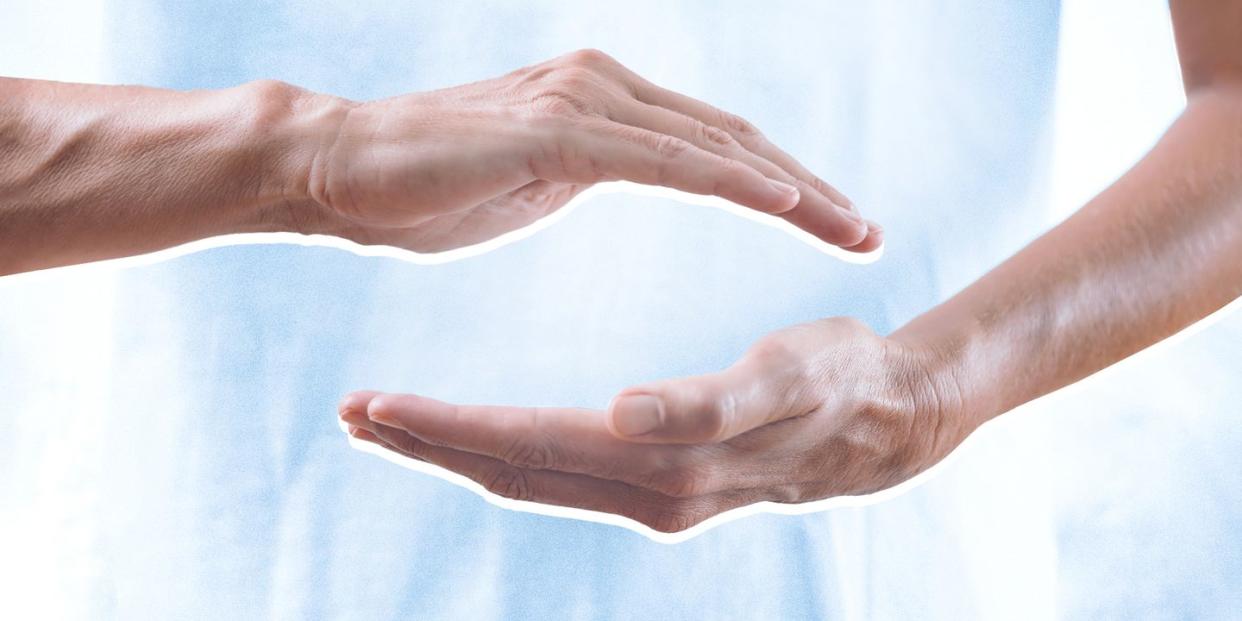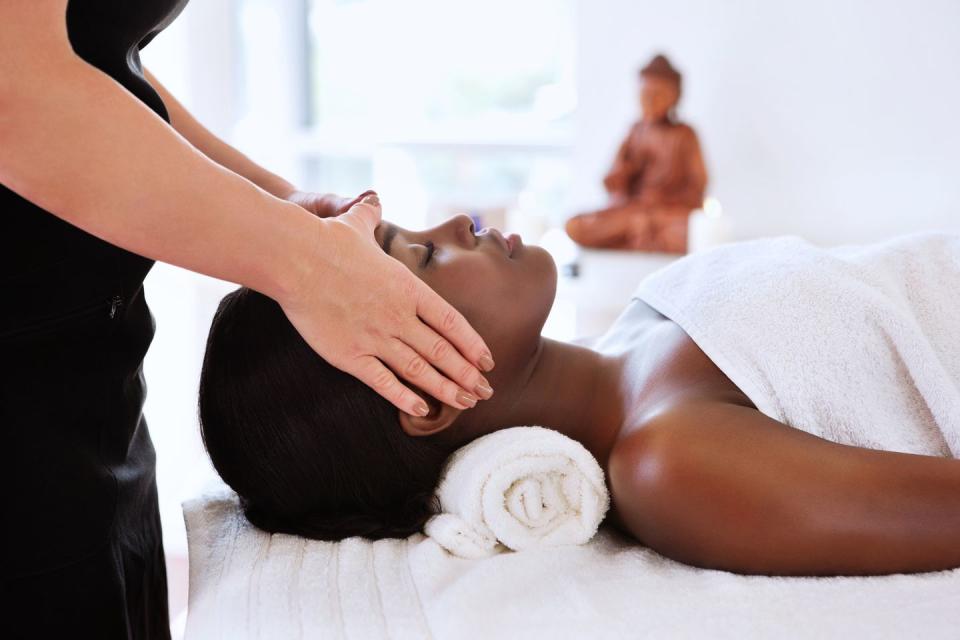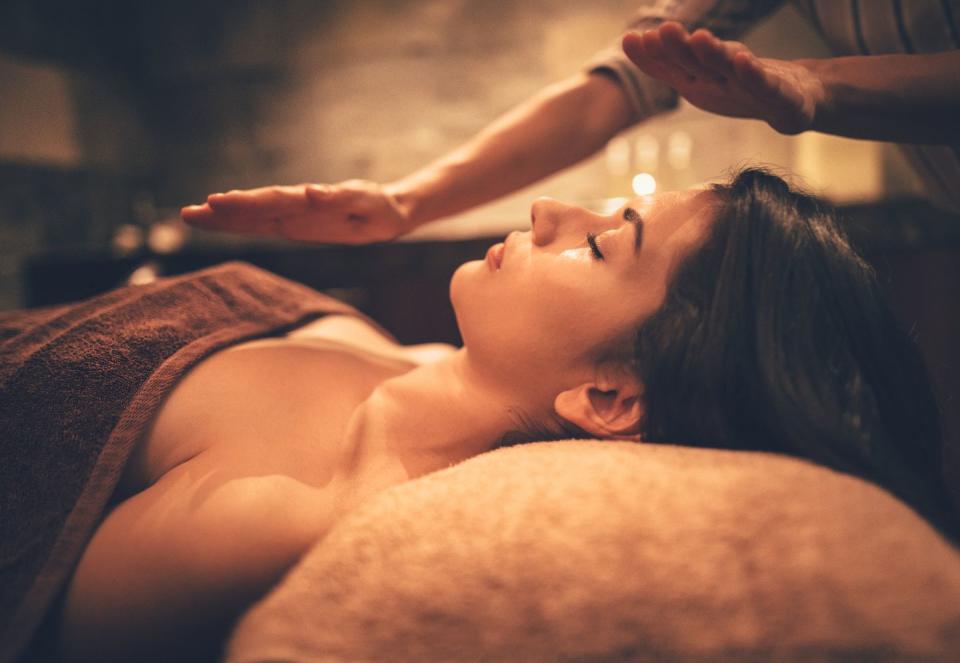What Are the Benefits of a Reiki Session?

“Hearst Magazines and Verizon Media may earn commission or revenue on some items through the links below.”
In the world of wellness, there are countless practices that have gained rising popularity among the masses, one of which is called Reiki. This energy healing practice has become an absolute hit; wellness practitioners and health gurus alike have all raved about the benefits of Reiki, and even celebrities like Gwyneth Paltrow have explored this alternative method of healing. Although it has become a relatively recent fan-favorite, this energy balancing technique existed long before it became a twenty-first century obsession. Developed by Dr. Mikao Usui in Japan during the early 1900s, Reiki was founded upon the theory that the process of channeling one’s energy can restore an individual’s overall wellbeing.
More: The Best Spa Retreats to Book Now for a Summer Escape
So, how exactly does Reiki work? Because of its theoretical foundation, many people find it difficult to understand the fundamentals of Reiki, and if you’re one of these people, we’ve got you covered. To fulfill your need for answers, we’ve consulted two Reiki specialists, Co-Founder of The SoulUnity Anna Toonk and Director of Vibrational Energy Healing at THE WELL Valerie Oula, who are both experts on this topic.
Let’s start with the basics, what is Reiki?
Reiki is a Japanese energy technique that refers to the use of channeling energy to balance the body, mind, and soul. However, it’s not to be confused with a massage, given that a massage incorporates a significant amount of pressure, whereas Reiki requires quite the opposite. "Through light touch with hands on and off the body, Reiki practitioners can help facilitate balance through the body," says Valerie Oula. “Everything has an energy field that is measurable in terms of frequency. Through Reiki, subtle shifts are created in the energy field to bring equilibrium."

How does Reiki work, and what is the exact method?
The method of Reiki relies heavily on a practitioner’s intuition regarding what they believe their client needs. So, in other words, there is no strict protocol when it comes to performing Reiki. “It depends on how my client enters the room— if they are super anxious, I’ll start at their feet to ground them and work their way up to their head,” says Anna Toonk. “As a practitioner, I’m not giving you my energy, I’m allowing universal neutral life force energy to move through me, flow through my hands, and channel through your body. With Reiki, it is channeled energy, so you have to open yourself up to allow that energy in. Ideally you want the energy to flow through you as if you are a conduit.”
Although there is a level of flexibility in terms of how energy specialists can perform Reiki, there are a few universal fundamentals that they must keep in mind to ensure that the Reiki session is effective. "As a Reiki practitioner, you have to be as neutral as possible," says Oula. "The recipient’s body draws what it needs through the practitioner from the universal energy field. In Reiki, we are working with life force energy which is also called prana or chi which flows through everyone and everything. There is no exchange of personal energy."
What are the benefits of Reiki?
Since Reiki is centered around channeling energy, most of the benefits are correlated with improving one’s state of mind by relieving stress or anxiety. “One of the things that is most powerful about Reiki is that it allows us to really receive, and to really be present in our bodies,” says Toonk. “Reiki can be really powerful in soothing anxiety because being present allows us to get to the underlying root of whatever is causing those feelings. Reiki specialists aren’t therapists, but we can offer a sense of support.”
However, an important note to keep in mind is that relieving anxiety is not equivalent to removing bad energy. "I often hear clients asking if Reiki can help clear bad energy, but it’s not really about good versus bad," says Oula. "I don’t subscribe to the idea of good or bad energy. Everything we feel and experience is valid and valuable. I like to remind my clients that as Reiki helps you to become more grounded, you create clear boundaries. When chaos is happening around you, a strengthened sense of energy helps you to not take it on."
Who should use Reiki?
Although Reiki is a useful tool for those who are struggling with anxiety, and even depression, it’s not limited to that function. “I would recommend Reiki to everyone—even babies or pets—because it’s such a gentle, soothing, and restorative practice,” says Toonk. “We all carry a load of different emotions, and I like to think of these feelings as glaciers in our body. Reiki helps to break up these glaciers so that pieces can begin to float to the surface, and therefore, we can become more aware of them. A lot of us avoid stillness because we think it’s going to be painful, but Reiki does the opposite, it makes us feel calm."

What are the Reiki principles?
Dr. Usui created five main precepts which help to guide Reiki practitioners, and although there have been variations of these principles overtime, Toonk explains that there is a general outline: “Just for today I will not worry, just for today I will not be angry, just for today I will be grateful, just for today I will do my work honestly, just for today I will be kind to every living thing.”
Oula notes that although these principles are used within the practice of Reiki, they can also be used as daily mantras that relieve stress and welcome a sense of peace: "For example, if you are anxious about the upcoming week, you might start Monday off with the first precept, saying to yourself, just for today, don’t worry."
Can I practice Reiki?
According to Toonk, you could technically give yourself Reiki at this very moment. However, to be a skilled Reiki practitioner, there is a certain level of proficiency that must be attained through learning. “I’m a Reiki master, the highest level you could be,” Toonk explains. “As a practitioner, you receive what’s called attunement, and this process allows you to channel energy more efficiently.”
If you simply want to begin practicing the simpler elements of Reiki, there are certainly ways to do so. Oula believes the best approach to learning Reiki is to start developing meditation skills. “It's through meditation that you can start to tap into the things that are more subtle— with Reiki, we’re working with subtle energy, and subtle energy requires a different kind of listening and language," she says. "I wrote a book called A Little Bit of Reiki, it’s a short primer on Reiki, and there are exercises within the book — meditation is an excellent way to practice opening your awareness.”
You Might Also Like

